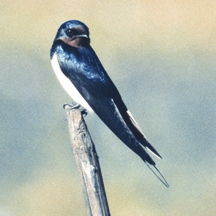Swallow

Swallow (ababil) small, gregarious, aerial-feeding insectivorous birds with a short broad bill surrounded by bristles and wide gape, occurring almost worldwide. There are about 90 species of swallows, including the martins, which belong to the family Paridae and Hirundinidae. Swallows have long, narrow wings forked tails and weak feet. They are extremely graceful in flight, twisting and turning, and making abrupt changes in speed and direction as they feed on the wing, catching insects in their wide mouths. Their plumage is blue or black with a metallic lusture, generally darker above than below. They nest in flocks in barns, sheds, chimneys, or other secluded places. They usually make cup-shaped nests of mud pellets and straw. There may be up to six eggs, pure white or spotted. Bangladesh has 4 species of swallows, of which 3 are migratory, and one species of martin. The resident species Wire-tailed Swallow (Hirundo smithii), and Plain Martin (Riparia paludicola) belong to family Paridae. The migratory species Red-rumped Swallow (Hirundo daurica), Barn Swallow (H. rustica), and Striated Swallow (H. striolata) belong to family Hirundinidae.
Swallows are the best-loved birds in the Western world. While owls and ravens are birds of ill omen, foretelling doom, the swallow is a bird of glad tidings, of comfort and joy. It was a swallow that tried to console Christ on the Cross. There is no Biblical authority for this, of course, there is only Christian legend. Swallows devour quantities of crop destroying insects. Its wings in proportion to its body are long, accounting for the life-on-the-wing of these birds and their powers of sustained flight. The wing tips are slotted, with the result that swallows can brake, roll, descend or mount with the most accurate oscillations as they dart into their nests, under a bridge or into holes. Also, the structure of the wings permits the astounding 'towering' of the birds, the sudden shooting up after a few starter flaps. Swallows can turn with a swiftness to outwit any flying insect, or drop straight down from the sky and then, just before touching the surface of pond or stream, shift vertical into horizontal flight.
The weak point in swallow anatomy is the small size of their feet, which makes perching difficult. Telephone wires seem to be their easiest perches, and the young after leaving the nest are often fed as they cling to the wires. People regarded the swallow as a weather bird. When the swallow flies low, cool weather and rain are coming; when it flies high, warm sunny weather will continue. And this is, roughly, correct. For insects follow weather conditions, and where insects go, the swallow flies.
Due to the Quranic reference, the Muslims do not kill the swallows. It is stated that once Abraha Ibn al Sabah, surnamed al Ashram, ie the slit-nosed, king or viceroy of Yaman, set out towards Mecca to destroy the Holy Qaba, as the head of a considerable army, wherein were several elephants. The Meccans, at his approach, retired to the neighbouring mountains, being unable to defend their city and holy place; but Allah Himself undertook the protection of both. For, when Abraha drew near to Mecca, and would have entered in it, the elephant on which he rode, named Mahmud, refused to advance any near to the town, but knelt down whenever they endeavoured to force him that way. While matters were in this posture, all on a sudden a large flock of birds, the Ababils came flying from the sea coast, every one of which carried minute pieces of stones, and threw those down upon the heads of Abraha's men, certainly killing every one they struck. The rest fled towards Yaman, but perished by the way, none of them reaching Sanaa, except only Abraha himself, who died soon after his arrival there. [Md Anwarul Islam]
